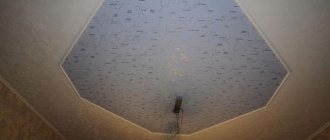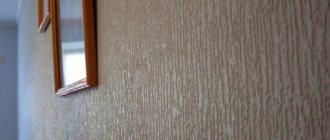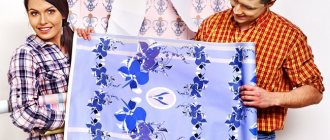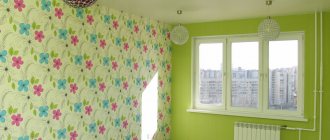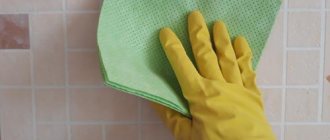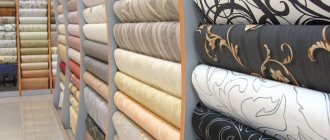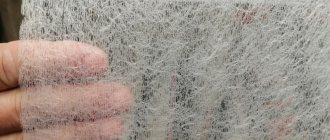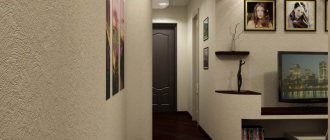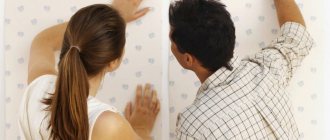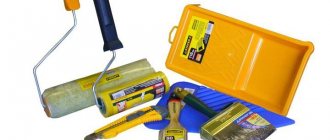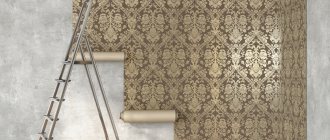The modern market offers a huge selection of wall coverings, among which wallpaper occupies a special place. There are many types of them, and it is very important to properly care for such a finish, regardless of whether it is moisture resistant or not.
Let's take a closer look at whether non-woven wallpaper and other types of these materials can be washed, and whether cleaning will spoil their surface.
How to wash non-woven vinyl wallpaper
These coatings have many advantages compared to paper and some others. They are not only easy to glue, but can also be washed and painted several times. But not everyone knows how to properly wash non-woven wallpaper so as not to damage its texture and pattern.
Folk remedies
Citric acid is used to clean this coating. For this you need 3 tbsp. Dilute spoons of powder in 200 ml of water (warm), moisten a soft cloth with the solution and apply it to the wall. Wait 3-5 minutes, repeat the procedure to remove dirt and dry the surface.
Purchased funds
Let's consider the general algorithm of actions when cleaning walls using household chemicals.
Required:
- cloth or sponge;
- water in a basin or other container;
- detergent (for example, dishwashing detergent or any other preparation).
The wallpaper cleaning process is quick and easy. To work, you just need to prepare the necessary materials.
Important: do not dry washable wallpaper with a hairdryer or by airing. This will not only not speed up the drying process, but can also ruin the wall coating.
- Prepare a solution of detergent and water in a ratio of 1 tsp. per liter respectively.
- Dip a sponge or cloth into the resulting mixture and squeeze it out.
- Clean the wallpaper from top to bottom.
- Wipe the washed areas with a dry sponge, cloth or brush and leave to dry.
Expert advice
- After washing the wallpaper until it is completely dry, you do not need to ventilate the room, otherwise all your efforts will come to nothing - the wallpaper will come off the walls.
- Under no circumstances should you use a fan or hair dryer to dry the wallpaper, as this will damage the coating.
- Movements should be fast so that the wallpaper does not absorb large amounts of moisture.
- If there are problem spots on the wall that you can’t get rid of, you can re-glue a small piece of wallpaper.
- If you can’t remove the stain and you don’t have the desire or time to re-stick the wallpaper, you can think about what elements you can use to hide the stain. You can rearrange it, buy an interesting painting, put a child’s drawing in a frame, a watch will do.
Vinyl wallpaper is suitable for renovation not only at home, but also in the office. Proper care of the coating will ensure its long service life.
How to wash paper-based vinyl wallpaper
Let's consider whether wallpaper with a paper base can be washed.
Folk remedies
Such coatings can be easily cleaned with laundry soap. To do this, just prepare a solution. It should be done in a ratio of 1:10 in relation to detergent to water. You need to carefully apply the composition to the wall using a rag, then you need to rinse it, wring it out and remove any remaining soap from the treated area.
Purchased funds
Paper-based vinyl wallpaper can only be wiped with a damp cloth and detergent. If the contamination is strong, it is allowed to wash the coverings, but do it very quickly, in the same way as non-woven ones.
Ensure sanitary and hygienic standards
Wallpaper, even with increased performance characteristics, sooner or later becomes dirty. This is explained, first of all, by operating conditions. If they are glued in the hallway, then the entrance area bears the largest dirt load.
It is not surprising that scratches and stains appear on the walls over time. But even if you put wallpaper in the bedroom, where it is always kept clean, household dust accumulates on the walls over time. Static electricity promotes attraction. Therefore, sooner or later the question arises of how to clean vinyl wallpaper from dirt.
Washable wallpaper is a relative concept. Even if the manufacturer allows this possibility, we are only talking about gentle ways to eliminate dust deposits.
In no case should you allow intense movements when cleaning vinyl wallpaper. Such cleaning cannot be compared, for example, with washing windows.
Excessive physical effort can result in:
- bending or stretching of the wallpaper;
- peeling of the strip;
- blurring the drawing;
- smoothing the relief elements of the ornament.
In the most pessimistic scenario, excess moisture can cause mold to form behind the canvas. In this case, cosmetic repairs will be inevitable, since mold, like any fungus, tends to spread over the entire surface. In addition, it is extremely harmful to the respiratory organs.
How to remove grease from washable trim
Grease stains, splashes, and fingerprints can be washed off in several ways. To do this you will need readily available materials.
Important: any wallpaper must be washed very quickly so that it does not get damaged or come off the wall.
Grease stains appear more often in the kitchen. They are most easily removed with baby powder. This is done as follows:
- Sprinkle a sponge or rag with talcum powder.
- They wipe the wall. Leave for 10 minutes.
- Remove the powder with a dry cloth.
There is another way to remove grease stains. It involves using an iron and paper towel.
- Place a napkin over the stained area.
- Carefully iron this area with an iron.
Traditional methods for removing stains from wallpaper
Washing off dirt with improvised means that every housewife has at home allows you to get a decent result and does not require additional costs.
Cleaning from dirt
The most popular methods:
- Prepare an aqueous solution of baking soda at the rate of 20 g of soda per 1 liter of water. Use a sponge soaked in liquid (should not run off, squeeze out excess) to wash away dirt from the wallpaper. Then wipe the treated surface with a cotton rag soaked in plain water.
- Prepare a soap solution. Proceed as in the previous case.
A soap or soda solution is a universal remedy that allows you to get rid of dust and general dirt. For stubborn stains, try other cleaning options.
After wallpapering, traces of glue usually remain at the joints.
Getting rid of some types of adhesives is problematic, but the following advice sometimes allows you to get a good result:
- Soak a cotton pad in 95% vinegar.
- Wipe the area with any remaining glue.
- After 10 minutes, remove vinegar stains with a wet cloth.
Removing greasy stains
Grease stains on the walls in the kitchen are quite common.
You can get rid of them this way:
- Using talc. Pour talc onto a sponge, rub the greasy stain, leave for 10 minutes. Remove any remaining talc.
- Using paper. Place a clean sheet of white paper on the stain. Iron the sheet with a warm, but not hot, iron until the paper has absorbed all the fat. Change paper whenever it gets dirty.
After removing the stain, wipe the surface with a damp cloth.
Pen marks
The ink is difficult to remove, but the following methods will give you a satisfactory result:
- Dilute potassium permanganate in 5% vinegar to achieve a rich crimson color. Soak a cotton pad in the resulting solution and wash off the ink mark. To remove fine lines, brushes should be used. Before drying, wash the resulting stains with a cloth soaked in hydrogen peroxide.
- Add 20 g of citric acid to half a glass of water and stir. Treat ink stains in the same way.
- Buy a melamine sponge. Erase the ink using the sponge as an eraser.
Be sure to read:
How to clean tiles from old mortar, cement and use them again
Regular pen erasers also allow you to make the pen mark almost invisible.
Plasticine
Sequencing:
- Carefully cut off the “extra” plasticine with a knife.
- Using a running hair dryer, heat the remaining plasticine and remove it with a napkin or toilet paper. As a result, a greasy stain remains.
- Soak a cloth in a concentrated solution of laundry soap and use a circular motion to wash off the stain.
- If necessary, go over the problem area again with a clean, wet cloth.
You can evaluate the result after the walls have completely dried.
Blood stains
There are several options:
- Suitable for moisture-resistant wallpaper. Use a wet cloth to soak the blood stain and wipe it away.
- Apply a few drops of hydrogen peroxide to a cotton pad. Apply it to the stain, the peroxide dissolves the blood, and it is absorbed into the cotton wool.
The second method is more acceptable for wallpaper that is not very durable.
Removing brilliant green
Known methods:
- Moisten the stain with water, cover with a thin layer of baking soda, add a drop of 5% vinegar. Rub lightly with a damp cloth to remove any remaining components.
- Add a little water to the starch and stir. Apply the resulting mixture to the green stain. Wait until the mixture dries completely. The green stuff should be absorbed into the starch. Wipe off any remaining product with a dry cloth.
- The method is suitable for light-colored canvases. Moisten a cotton pad with hydrogen peroxide or alcohol and wipe the stain with it. After an hour, remove the stain with a damp cloth.
How to clean markers and ink from walls
If such “art” decorates your room, don’t be upset. These stains can be washed out from wallpaper that is not silkscreen or paper.
In addition, pay attention to the type of markers: if they are alcohol-based, the drawing can be easily erased with alcohol or vinegar, rubbing the liquid into the stain with a cotton pad. It is much easier with water-based markers; they are washed off with plain soapy water.
Fingerprints can be removed using an eraser. To do this, just rub the stain with a little force.
Basic rules for cleaning wallpaper
Before cleaning, you need to find out what type of wallpaper it is, what material it is made of and whether it can be washed with water. All this information is usually indicated on the packaging.
So, what types of canvases are there:
- waterproof wallpaper, which can be gently wiped with a damp cloth;
- washable wallpaper - they can be cleaned with soap or some other cleaning solution;
- super-resistant to water use - which means you can use absolutely any cleaning products;
- super resistant to cleaning and friction - you don’t have to worry about such wallpaper, it will withstand everything.
All this information is usually indicated on the packaging in the form of pictures and inscriptions. If the label is not preserved, you can find similar wallpaper in the store and check with a consultant for cleaning conditions. Or try the cleaning agent on an inconspicuous area of the fabric and draw the appropriate conclusions.
How to wash before painting
If the wallpaper is to be painted, it must first be degreased and free of dust.
You can simply use a vacuum cleaner or steam cleaner for light cleaning, but if the dirt is more serious than dust, you need to wash the wallpaper. This is done as follows:
- We wipe the wall covering with a cloth or sponge soaked in soapy water.
- We wipe the area with a dry cloth or soft washcloth.
- Let the wall dry. You need to let it dry completely, but without a hairdryer or draft. After this, it will be possible to produce high-quality painting.
Pros and cons of the material
Non-woven wallpaper is intended for wall decoration. Consist of non-woven backing and foam vinyl. Non-woven fabrics have a thin paper base, which is covered with a layer of PVC film on top. The finishing material contained in compact vinyl film is not afraid of moisture and cleaning devices, be it a hard brush or a damp sponge. Foamed vinyl film is resistant to cleaning with a damp cloth soaked in a solution of detergents.
Among the advantages of the material the following are noted:
- recognized as environmentally friendly;
- it has high elasticity and strength;
- has the ability to hide wall defects;
- can be painted;
- affordable price;
- practicality in operation.
Among the shortcomings are noted:
- the high cost of some wallpaper modifications;
- non-woven fabrics without additional composition are very thin, and therefore with the slightest defect they become unusable;
- a thin canvas can show through the previous paint color.
How to make your own hand wash
In addition to detergent and soap, baking soda is great for cleaning wall coverings. This solution can be prepared at home and from scrap materials. This folk method is based on soda.
What is needed for the solution
- soda - 40 g;
- warm water - 2 l.
How to clean a wall with baking soda
- Combine the powder with water. Mix thoroughly until smooth.
- Dip the sponge into the solution and carefully wipe the wall with it.
Important: baking soda will help get rid of not only dirt and grease, but also unpleasant odors. With special effort, you can even wipe away soot, plaque, and mold.
Stain removers
| Types of pollution | What to wash with? |
| Fat | Rub talcum powder or chalk into the stain, then clean with a rag; Use an iron to iron the stained area through a napkin or paper; Apply a cotton wool moistened with gasoline to the stain for several minutes. |
| Ballpoint pen and ink | You can clean it with a solution of potassium permanganate and vinegar, a solution of detergent and water, a melamine sponge, or rinse with half a lemon. |
| Felt pen | Clean the stained area with hydrogen peroxide, lemon juice or medical alcohol using a cotton swab. |
| Colour pencils | Rub with an eraser or toothbrush with washing powder. Gently wipe with solvent (vinyl wallpaper). Suitable for light surfaces. |
| Wax pencil and crayons | Dilute floor cleaner in water, rinse the surface and allow to dry. Or rub it with an eraser. |
| Fingerprints | Clean with an eraser, soda or talcum powder. Wash with soapy water. |
| Dye | Clean the stained area with acetone without touching the clean part of the wallpaper. You can try scraping off the dried paint. |
| Glue | Moisten a cloth with water and rinse the area of contamination using circular movements. |
| Plasticine | Gently scrape off with a knife and heat with a hairdryer, then clean the area with a slightly damp cloth. |
| Mold | Clean with a solution of baking soda in water, rinse with hydrogen peroxide. |
| Tobacco removal | Yellowness is difficult to remove. You can treat it with a vinegar solution and rub it with lemon juice. |
| Soot | To begin with, the walls can be cleaned with a vacuum cleaner. Then use a dry cleaning sponge, washing liquid or solvent. Paper wallpaper cannot be cleaned without damage; it is better to remove the old ones and stick on fresh ones. |
| Zelenka | Rinse with a solution of lemon juice, alcohol and water. Clean with hydrogen peroxide. |
| Pomade | Wash with soapy water or foam detergent. |
| Wine | Fresh stains can be washed with soapy water. An old stain is almost impossible to clean. |
With proper regular care, you can extend the life of your wallpaper and maintain the brightness of the colors. A little trick and a product that you almost always have on hand will help you get rid of unexpected stains and wash away dirt. It is important to remember that each type of wallpaper has a different composition and interacts with water differently; in order to avoid troubles, you need to take into account the instructions on the label.
What to do if there is no marking
There are special signs on the wallpaper. They show how the coating reacts to water and other external factors. For example, a marking with one wave means that the material can only be wiped with a damp cloth, with two such icons - you can use some detergents, with three - the wallpaper is very resistant to water and can be safely washed. And the sign with waves and a brush means that you can use a washing vacuum cleaner and other cleaning products.
But how do you know if non-woven vinyl wallpaper can be washed if there is no marking? If there are no signs, just check the reaction of the wallpaper to moisture in an inconspicuous place. To do this, just select a small corner of the coating and wash it in one of the following ways: if it is not damaged, you can continue working with the entire wall.
We looked at the main ways to properly wash wallpaper. This task is not so difficult if you follow all the recommendations in the article and video, and also avoid heavy contamination. You can use both purchased products and traditional cleaning methods for this procedure - your walls with a stylish coating will retain their fresh, original appearance for a long time!
What wallpaper can be washed
In order not to spoil the coating during cleaning, it is important to know which wallpapers are exposed to contact with moisture and which ones deteriorate due to this. Those fabrics that can be washed are called washable. These do not include all those available, but only some. The manufacturer puts special marks on the packaging, by which you can understand what category the product belongs to. Let's figure out how to find out whether decorative coatings can be washed?
One wave
The designation one wave in a square means increased moisture resistance. Wallpaper can absorb moisture, but it is not recommended to wet it on purpose - this will lead to its deformation and disruption of the pattern. They can be wiped with a slightly damp soft cloth. Additional cleaning agents must not be used. It is important to do all cleaning movements carefully, without resorting to force.
Two waves
The designation on the label for the roll - a square with two drawn waves - indicates the ability of the walls to come into contact with moisture. This can be done with a wet cloth, but carefully, without scraping. Otherwise, the top layer of the coating may be damaged.
Three waves
These symbols indicate that the fabrics are washable or super washable. The fabrics do not get wet from the action of water. In addition, foam-forming detergents can be added to the water.
wave with crest
Canvases with this sign on the label can be safely washed, and rubbing with rough material, for example, a melamine sponge and other fabrics, is allowed. It is allowed to clean such coatings with a washing vacuum cleaner. Usually the price for such wallpaper is quite high, but the result justifies the financial costs. You can glue them in the children's room, in the kitchen.
Wallpaper varnish
When you don’t want to quickly get rid of your favorite wallpaper, they are coated with a special varnish or PVA glue. This technique will allow you to cover the top layer of the canvas with a waterproof layer. The purpose of varnishing is to preserve the colors and designs. In addition, the walls will become brighter, the pattern will look clearer and more impressive.
- Most often, paper ones are varnished. The varnish chosen is colorless, which will give them waterproofness and shine. The best varnish is VAK-A-104.
- In order not to spoil the liquid wallpaper during cleaning, they are coated with a special Poliver treatment, which does not change the appearance of the coating.
- The canvas for painting is varnished only after applying the main paint, but this should not be done without paint.
Varnishes perform a protective function. In addition to moisture resistance, resistance to mechanical damage is added.
Advantages and disadvantages of non-woven coverings
Before subjecting the canvas to cleaning and washing, you need to know about its strengths and weaknesses. Features of the coating are:
- First of all, non-woven wallpaper can be washed, because... they are resistant to moisture.
- Air conductivity. Thanks to the small pores in the wallpaper, oxygen is evenly distributed throughout the room.
- Easy to install. Due to the lightness of the material, gluing does not take much effort and time. In addition, the glue is applied not to the product, but to the wall.
- Visually hides small defects in the wall surface.
- Susceptibility to translucency. If you do not use a neutral-colored primer or do not paint the canvas after gluing, everything will be visible when exposed to sunlight.
How to remove dust from paper wallpaper?
You can try removing dust stains with a dry cloth and iron. Using a heated (not hot) iron, iron the dusty area through a rag. After this, try to gently wipe off the dust. You can try removing greasy stains with an ordinary eraser.
Interesting materials:
How much should you take GABA? How long does it take to defrost a No Frost refrigerator? How much cash can you transport within the European Union? How many people are there in Russia? What is the population of Turkmenistan in 2022? How long do you not eat after cardio? How many weeks is Lent? How long should you run on the elliptical? How much boric acid is needed per bucket of water? How much FPS do you need in games?
Types of washable wallpaper
Washable wallpapers include acrylic and wax-coated ones. Their performance qualities depend on the composition and method of production, which determines their popularity for different types of premises.
Vinyl wallpapers
Most often, washable wallpaper is understood to be vinyl, which is explained by its wide distribution, huge selection and affordable price.
. They do not fade in the sun, are durable, and for rooms with high humidity it is better to choose non-woven fabric as a base rather than paper. This is an excellent material for bathrooms and kitchens.
Depending on the specifics of production, washable vinyl wallpaper can be of different types:
Acrylic wallpaper
In many ways they resemble vinyl foam types, but instead of polyvinyl chloride, acrylic is used in production. The basis is paper, and acrylic is applied not in a continuous layer, but in a spot
, hence the main properties of such wallpaper.
Thanks to the structure of the outer layer, the material allows air to pass through
, allowing you to create a favorable microclimate in the room.
The material is durable, practical, wear-resistant
, but in terms of performance it is still inferior to vinyl wallpaper.
The thickness of the outer layer is 2 mm, while for vinyl wallpaper the same figure is 4 mm. This explains the lower durability, but acrylic wallpaper can also be washed, but do not use abrasive detergents or too hard brushes
- a soft sponge and plain water are optimal.
The vapor permeability
of this material expands the scope of use of wallpaper: it is acceptable even in bedrooms and living rooms. The choice of colors and patterns is quite varied.
Glass wallpaper
made from natural materials: the material is based on glass threads, which are woven like fabric, and special impregnations are used to give strength. The main advantages of glass wallpaper include:
- naturalness and vapor permeability;
- strength and wear resistance. It will not be possible to scratch such a coating so easily;
- non-flammability;
- durability;
- the ability to further strengthen walls and hide surface imperfections;
- Possibility of multiple dyeing.
Fiberglass wallpaper is sold both white and already painted in some color. In any case, if necessary, changing the color will not be difficult. To ensure that the wallpaper does not lose its cleaning properties, you need to choose the right paint. Water-dispersion, latex and acrylic paints are suitable.
As for the appearance, you can find several types of patterns on sale, such as herringbone, diamond, matting, etc. Depending on its depth, the maximum number of paint layers without loss of relief may vary and range from 6 to 20.
Metal wallpaper
- This is a two-layer material consisting of a paper or non-woven base and aluminum foil, which can be embossed, patterned, painted in a certain color. Initially, such wallpapers were assigned the function of protecting against electromagnetic radiation, but now they have become just an unusual decoration, which also has a lot of useful properties:
- durability;
- ease of gluing;
- soundproofing properties;
- resistance to prolonged exposure to sunlight;
- moisture resistance, which makes the wallpaper washable and easy to care for.
If you want to choose metallic wallpaper to decorate one of the rooms, you need to remember the high price of the material. Unfortunately, this is not the only drawback. This type of wallpaper does not breathe, the surface is easy to scratch
, during installation it is necessary to turn off the electricity and carefully level the surface. In return, the owner receives luxurious finishes. Often, metal wallpaper is used only for one of the walls: the one that will most often have to be cleaned of dirt.
Cork wallpaper with wax coating
– one of the most natural options for wall decoration, because they are made from the bark of the cork tree. The wallpaper itself does not have impressive moisture-resistant qualities, but thanks to the wax impregnation
Not only can they be used in rooms with high humidity, but they can also be washed.
In addition, cork wallpaper does not accumulate static electricity, has excellent sound and heat insulation qualities, is bactericidal, does not absorb odors, is durable and easy to care for. This material does not differ in a wide range of colors - rather, on the contrary. Cork wallpaper does not tolerate mechanical damage very well
, they are easy to scratch. Even after applying impregnations or varnishes, the surface can only be washed with water and a sponge, without aggressive agents or hard brushes.
Features of gluing
Each of the types of wallpaper described above has its own nuances in terms of installation, but there are some general points that are important to consider before gluing. Glue plays a particularly
, because it must be more powerful than the adhesive composition for ordinary, non-washable wallpaper. For example, for metal wallpaper you need a fungicide, for acrylic and glass wallpaper - acrylic glue, for vinyl - special compounds intended for this type of wallpaper.
Many of the listed types of wallpaper are capable of hiding small unevenness in the walls, but it is wrong to think that the thicker the material, the more effectively it hides defects. This ability depends on plasticity and relief, so all the holes will be visible through cork wallpaper, while vinyl and acrylic wallpaper will hide them.
The most vulnerable place of washable wallpaper is the seams
, so when gluing them you should pay maximum attention.
It is better to spend more time creating neat and even joints than to negate all the unique properties of the wallpaper with careless gluing. And finally, it is important to note that washable wallpaper should be washed only when it becomes dirty - it is better not to touch it again .
During the period of preparation for the spring church holidays, it is customary to restore order in the house. If you're doing some general cleaning, it's a good idea to wash the wallpaper. It will be more pleasing to the eye and the air in the apartment will be fresher. Today we’ll look at how to wash non-woven, vinyl, paper, washable wallpaper and paintable wallpaper in an apartment or house.
If the wallpaper packaging has been preserved, the markings on the label will help you determine the type of washing. These are the special designations:
2.
Two waves. The coating can be washed using a soap solution and a soft sponge.
3.
Three waves. When washing wallpaper, you can even use household chemicals.
4.
Waves with crest symbol. The coating can be washed with a brush and a vacuum cleaner.
If the packaging is not preserved, focus on the type of wallpaper - paper, vinyl or non-woven - and follow the following instructions. If the type of wallpaper is completely unknown to you, it is better to play it safe and use the most gentle care option. As a last resort, you can experiment with a small strip of wallpaper (you probably have scraps left over). If the wallpaper cannot be washed, the trim will become unusable.
